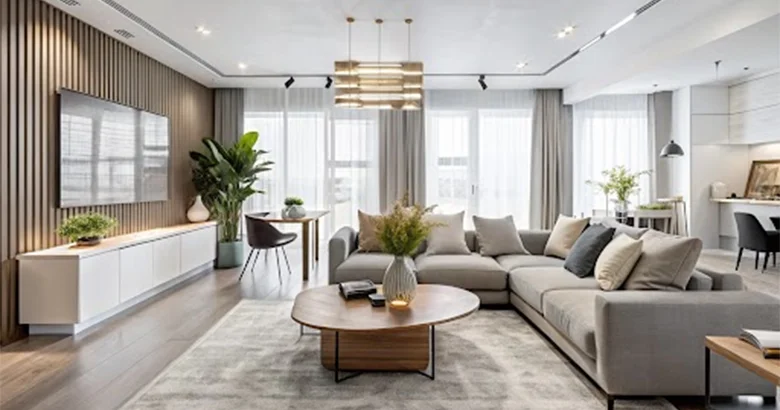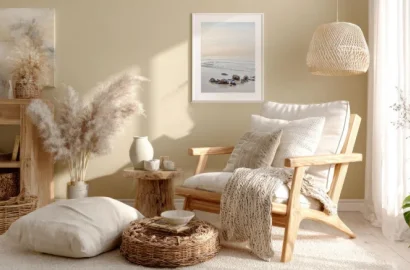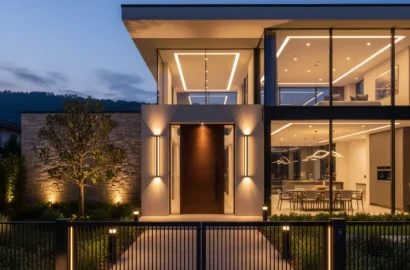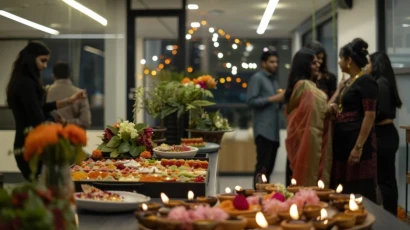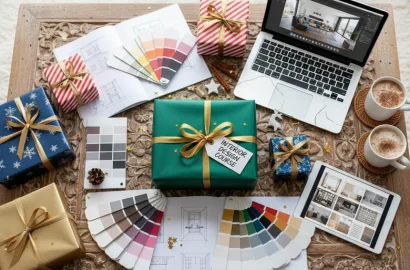Read on to understand all about modern interior design and space planning, budget-friendly tips, and more to elevate your living room style.
Welcome to the world of modern living room design, the roots of which, go back to the early to mid-20th century with influences from the Bauhaus movement; (German for ‘building house’), Scandinavian simplicity, and mid-century modern aesthetics. These design styles had one common core principle: create pretty living spaces that also functioned well and stood the test of time. In the modern world, this principle has been updated to reflect contemporary needs, such as sustainable living, smart home integration, and the shift toward open-plan living.
Through this guide, we try to bring to you more than just another collection of overly perfect ideas. We will walk you through the key principles and psychology of interior design for modern living rooms providing tips and explaining everything from color schemes to furniture choices, lighting, and decor.
Here is what we have discussed in the article!
- Understanding Modern Living Room Interior Design
- Modern Living Room Layout and Space Planning
- Bringing Nature Indoors with Modern Design
- Budget-Friendly Tips for a Modern Living Room
Understanding Modern Living Room Interior Design
Modern living room design is about minimalistic design, clean lines, and functionality –a design philosophy that emphasizes simplicity and openness. Minimalism emerged in the late 1950s as a reaction against the excesses of complicated and flashy styles of art, like abstract expressionism. It took inspiration from movements–De Stijl (Dutch for “The Style”) and the Bauhaus. Modernists like Le Corbusier and Ludwig Mies van der Rohe emphasized clean lines in their buildings. Mies famously said, “Less is more,” advocating for simplicity and clarity in design. The Bauhaus Idea that the shape of a building or object should primarily relate to its intended function again greatly influenced functionality as a design philosophy.
In a world overwhelmed by information and material possessions, minimalist design offers a release. The goal is about creating a calming, clutter-free environment—because in a world overloaded with social media notifications, emails, and that giant list of things we need to do but won’t, minimalism gives our minds a little breathing room. Then comes clean lines; If a black-and-white sketch of the room has several straight lines and sharp angles, it aligns with the ‘clean lines’ design philosophy. Lastly, functionality is the quiet superhero of modern design. It is not only about how things look but about how they work. Every piece of furniture and every storage solution is designed to serve more than one purpose.
Key Features In Modern Living Room Design
When it comes to creating the perfect modern living room, there’s more to consider than just the furniture and layout. The ambiance—how the space makes you feel—is just as important.
Color influences mood, lighting adds drama depending on its placement and intensity. And the scent makes for an immersive experience.
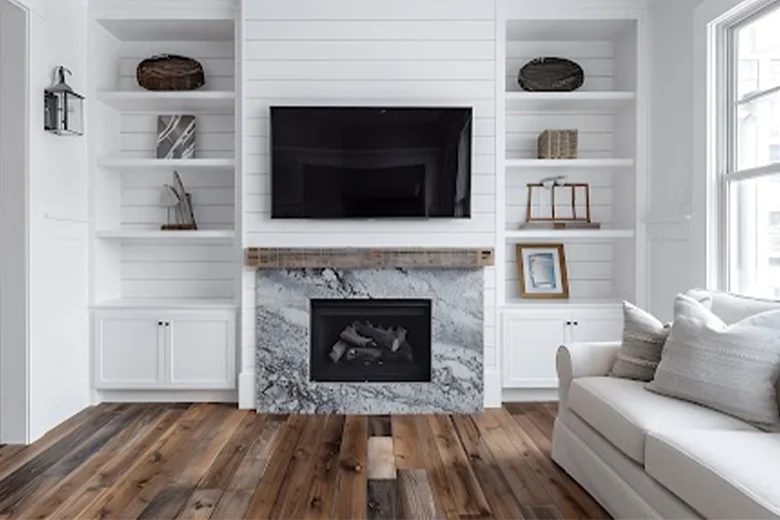
The Role of Color in Modern Interiors
Color is one of the most powerful tools an interior designer can use. In modern living rooms where simplicity and minimalism are chief, the color palette you choose sets the overall tone and mood of the room, influencing how it feels to inhabit the space.
Behavioral science tells us that colors can have a profound effect on our emotions and behaviors. Neutral shades like white, beige, and grey, which are prevalent in modern design, give feelings of calm, stability, and openness as they are easy on the eyes. These colors help reduce visual noise. This is why modern living rooms often use neutral backdrops—they offer a psychological “reset” from the overstimulation of the outside world.
However, neutral doesn’t have to mean boring. Pops of color can be introduced through art, decor, or furniture choice. For example, color psychology suggests that blues and greens are calming, making them ideal for a relaxing environment, and colors like yellow and orange can stimulate creativity and conversation.
Lighting Techniques for a Modern Living Room
Lighting in modern interior design enhances the mood, highlights architectural features, and can even make a room feel larger or smaller. It is not just about seeing where you’re going—it’s about setting the mood or the vibe, like an Instagram filter.
Layered lighting is one of the most effective and popular techniques for achieving a modern look. Try combining different types of lighting to create a dynamic atmosphere. Ambient lighting provides illumination in large areas, task lighting focuses on getting things done–like reading or pretending to read. Accent lighting, literally, highlights the things that you splurged on and want people to look at –artwork or architectural features.
Recessed lighting is also a popular choice in modern interiors, as it offers clean, unobtrusive– ‘non-sharp’ illumination without tiring the eyes. This with sleek floor or table lamps that add functionality without cluttering the room complements low-profile designs with geometric shapes or metallic finishes that align with the minimalist aesthetic.
Natural light is equally important in modern interior design. Large, unobstructed windows and sheer curtains can maximize sunlight, making the living room feel airy. The interplay between natural and artificial light helps create a dynamic space.
Role of Smell in Interior Design
The role of scent is equally important when it comes to interior design but is often overlooked. Scents have a strong connection to memory and emotion, influencing how a space makes us feel. For instance, light floral or earthy scents like lavender, eucalyptus, or sandalwood can complement the minimalist aesthetic, filling the space with a natural ambiance that goes with indoor plants and natural materials like wood and stone.
The key here is subtlety. Overpowering scents can disrupt the clean, minimalist vibe. Essential oil diffusers, atomizers, scented candles, or natural air fresheners can be used to bring fragrance gently into the room. Go for vessels that align with your decor.
Just as colors and textures create the visual identity of your living room, scent can become part of your room’s “signature.” Many high-end hotels, for example, are known for their distinctive scents, which become a part of their brand identity.

Furniture Selection for a Modern Living Room
While choosing furniture focus on those with simple, streamlined designs. Call back to the ‘clean lines’ design philosophy. Furniture in modern living rooms has to be functional yet stylish. Think about low-profile sofas, sleek coffee tables, and modular seating that allows for flexibility.
Studies on biophilic design suggest that introducing natural elements into interior spaces can reduce stress levels. Wood, for instance, is associated with warmth and comfort leading to feelings of security and relaxation. Metals, on the other hand, convey a sense of strength and stability. When used in furniture like table legs or chair frames, metals can create a visual contrast that can add to the modern feel without overpowering the room’s natural warmth. The balance between natural materials like wood and industrial elements like metal gives a feeling of harmony.
Modular Sofas and Sleek Coffee Tables are a Great Addition
Modular sofas are quite the appealing form in modern living rooms due to their versatility. From a psychological perspective, this flexibility is in line with the concept of “cognitive ease”—the idea that people prefer environments where they can effortlessly change or adapt their surroundings based on their needs. A modular sofa will allow for a rearrangement of seating based on your mood, your social plans, your latest cleaning spree, or simply lounging in solitude. This adaptability leads to a feeling of control.
Pair a modular sofa with a sleek, minimalist coffee table—think glass tops or thin, polished wood. Glass-top coffee tables are particularly popular in modern design because they create the illusion of more space allowing light to flow freely throughout the room which contributes to a sense of openness and mental clarity.
Using Smart Storage Solutions
Installing built-in shelves, floating storage units, and hidden compartments helps to maintain an organized, visually clean environment. Also, the principle of “out of sight, out of mind” applies here. When belongings are stored away from the field of view, they are less likely to distract or stress people out in the room. This approach is aligned with the concept of environmental mastery by Ryff and Keyes, which refers to an individual’s ability to manage their surroundings. A well-organized space gives people a sense of control.
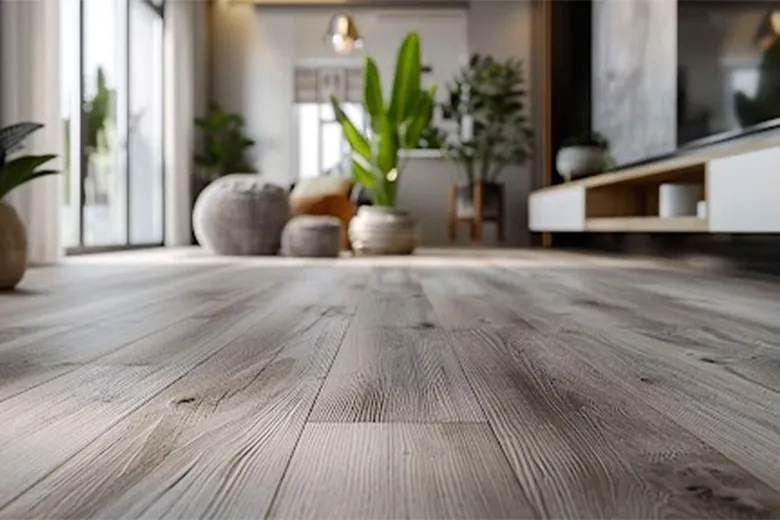
Flooring Options for a Modern Look
Choosing the right flooring is essential to establish the desired aesthetic in a modern living room. It’s not just about durability and practicality, but also about how the flooring complements the overall design and atmosphere. You can choose from popular choices for modern interiors such as hardwood and polished concrete, both of which offer unique qualities that contribute to a modern, stylish living space. Read on for some more options.
Hardwood Flooring
Hardwood flooring offers warmth and vintage beauty. With a wide range of wood types, finishes, and patterns, hardwood can enhance the aesthetic of a room. However, it requires maintenance and can be prone to scratches.
Polished Concrete Flooring
Polished concrete provides a sleek, industrial look that fits in minimalist spaces. Known for durability, it’s highly resistant to scratches and stains, making it low-maintenance. Paired with radiant heating, it solves the issue of being cold underfoot.
Laminate Flooring
Laminate flooring is a budget-friendly alternative to hardwood and comes with a similar look without the high cost. It is scratch and stain-resistant, easy to install, and low-maintenance. However, it lacks the longevity and refinement of real hardwood and can’t be refinished.
Luxury Vinyl Plank (LVP) Flooring
Luxury Vinyl Plank (LVP) has the appearance of wood or stone while being more durable and waterproof, making it ideal for high-traffic areas or spaces that may have moisture. It is affordable and low-maintenance, though it does not quite match the feel or warmth of natural materials like hardwood.
Tile Flooring (Porcelain & Ceramic)
Tile flooring, whether porcelain or ceramic, makes for a clean, contemporary look. It’s water-resistant, durable, and easy to maintain, making it suitable for modern living rooms. These tiles can feel cold and hard underfoot, and certain types can also become slippery when wet.
Natural Stone Flooring
Natural stone flooring, such as marble, slate, or granite, brings luxury and elegance to any modern space. However, it’s more expensive to install and requires regular maintenance, including sealing, to protect its surface from stains and moisture.
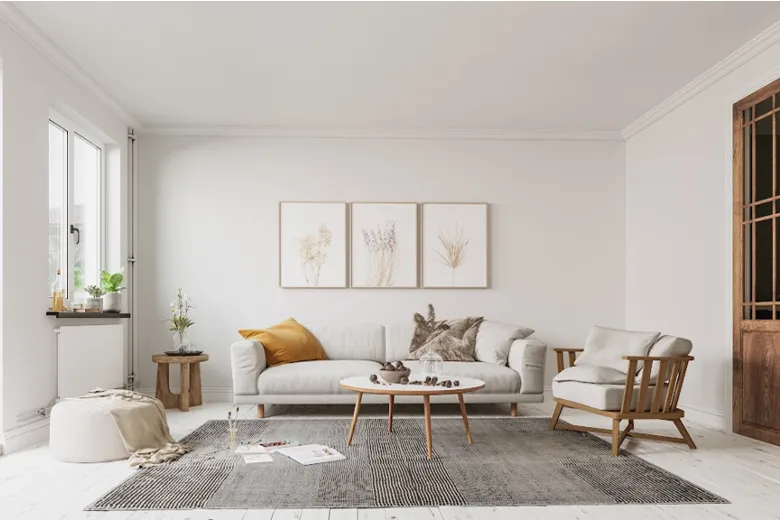
Wall Art and Decor in Modern Living Rooms
While modern design leans toward minimalism, that does not mean your walls have to be bare. Minimalist wall art can add personality without overwhelming the room. Choose pieces that are simple yet impactful—think geometric shapes, abstract designs, or black-and-white photography. The outline or frame of art pieces if thoughtfully chosen, can bring variety as well,
Minimalist Wall Art Ideas
Minimalist wall art is about simplicity. It makes a statement without being excessive. Large, single-statement pieces are often more effective in modern living rooms than multiple smaller ones. A large piece of abstract art or a framed black-and-white photo can capture attention and serve as the point of focus in the room. Line art and subtle paintings are also excellent options.
It is important to remember that less is more in modern design. One well-chosen piece of art can be more impactful than a wall filled with many items. This allows the art to breathe, creating a peaceful, uncluttered atmosphere while still making a stylish statement.
Introducing Technology into Modern Living Rooms
Modern living rooms often use technology in ways that complement the sleek, uncluttered aesthetic of the design. The key is to integrate tech seamlessly so it enhances the space without dominating it. Smart home technologies are a great fit for this approach as they have features like voice-controlled lighting, hidden speakers, and flat-screen TVs that retract into the wall to help keep the room looking clean and streamlined. This way, you get the convenience of advanced tech without compromising the appearance. The trick here is to hide the wires and minimize buttons.
Modern Living Room Layout and Space Planning
A key feature of modern design is the open floor plan, which removes walls to create a seamless flow between the living room and other areas. Think of it as the ‘anti-wall’ movement, where the kitchen, dining room, and living room can all mingle freely, like a perfectly planned cocktail party. This layout makes your space feel larger and actively encourages social interaction. No more hiding in the kitchen while guests hang out in the living room; everyone gets to witness your culinary skills or your favorite fast food addiction. To maintain this sense of openness, choose low-profile furniture, which means selecting pieces that are sleek and do not dominate the space. A low profile can also mean low height.
Within an open floor plan, it is important to create distinct zones for different activities. Zoning involves using furniture and decor to define specific areas without using physical barriers. For example, placing a rug under the seating area can ‘define’ a lounging zone, while a console table can help separate different ‘functional’ areas. This method organizes the space.
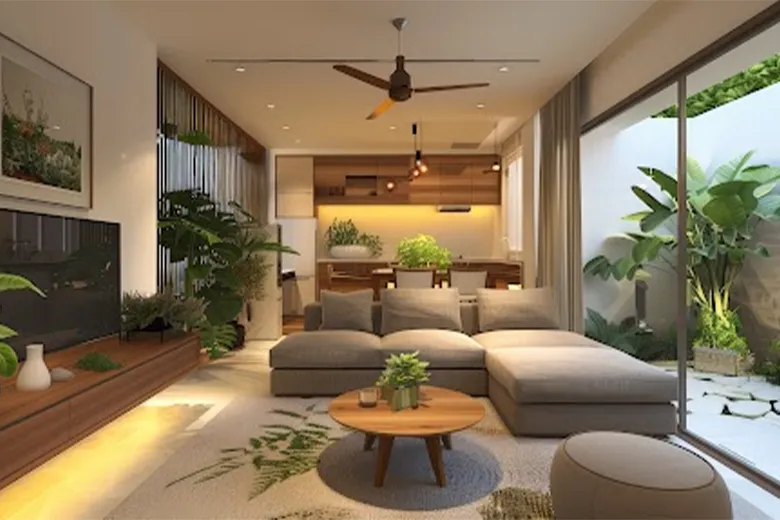
Bringing Nature Indoors with Modern Design
Modern design and nature can complement each other. Introducing indoor plants and natural materials, like wood and stone, into a modern living room helps soften the clean lines and neutral tones. Plants also enhance the room’s aesthetic and improve air quality. Natural elements like wood and stone further provide warmth and texture to an otherwise minimalist space.
Indoor Plants that Complement Modern Interiors
Plants are the perfect antidote to the sometimes clinical feel of the minimalist design, bringing life, color, and a breath of fresh air into the room—literally. Certain indoor plants are particularly well-suited to modern living rooms. Snake plants (Sansevieria) are known for their upright, architectural shape and structure. Fiddle leaf figs (Ficus lyrata) have large, glossy leaves that add a dramatic vibe. Succulents are a wide range of plants with thick, fleshy leaves adapted to store water, making them good for smaller spaces. To sustain a modern aesthetic, put these plants in minimalist pots.
Natural Materials and Textures
Wood provides warmth and texture, whether in flooring, shelving, or furniture. Stone, such as marble or granite, offers a contrast when used in places like fireplaces or accent walls. Metal elements, like steel or brass, make for a contemporary design language. The key is to use these materials thoughtfully to enhance, and not overwhelm.

Budget-Friendly Tip for a Modern Living Room
You do not need to start a private equity firm and short-sell stocks to achieve a modern living room design. Go for affordable furniture from retailers that offer minimalist designs. DIY decor—simple projects like painting your own artwork or refurbishing/repainting an old piece of furniture can give a personal touch without breaking the bank. Thrift stores are also a great place to find unique, modern pieces at low cost.
Thrift shopping is a treasure hunt, an adventure, a premium experience; and you will be surprised at what you can find. Look for items with again, clean lines and neutral colors that fit the modern interior design style. Sometimes all a piece needs is either fresh paint or a new set of legs to look brand new.
Conclusion
At the end of the day, modern living room design isn’t about conforming to a sterile aesthetic or creating a showroom-perfect space. It is about curating a room that serves your needs—both practical and emotional. By focusing on clean lines, neutral colors, and functional furniture, you can create a space that feels both stylish and comfortable. Go ahead—embrace the power of a well-placed houseplant, a sleek couch, and a little extra sunlight!
If you intend to seek further practical guidance in the process of revamping or designing your space, we recommend taking a look at these projects:
- Residential Interior Design Project by AND learner Anusha Somasundaram
- Commercial Interior Design Project by AND learner Jaladhi Shah
Next Steps
We hope that this guide has helped you understand the workings of modern living room interior design and empowered you to incorporate our tips into your home or future projects.
To learn more about interior design, visit our blog, or consider the following resources:
- Watch this session by Snehanshu Mukherjee, Founding Partner at T.E.A.M, and Mansi Almadi, an Interior Designer at Studio Lotus
- Talk to a course advisor to discuss how you can transform your career with one of our courses.
- Check out our Interior Design courses – all courses are taught through live, interactive classes by industry experts.
- Take advantage of the scholarship and funding options that come with our courses to overcome any financial hurdle on the path of your career transformation.
Note: All information and/or data from external sources is believed to be accurate as of the date of publication.

